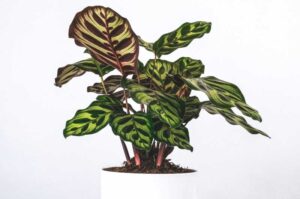Calathea ornata plant care guide (The Pinstripe Plant)
How to take care of Calathea ornata

Calathea ornata is an indoor plant belonging to the prayer-plants family. It is trending in social media these days because of its magnificent, vibrant colored leaves that have a definite multicolored pattern.
Calathea ornata is a plant with pink striped leaves also called the Pinstripe plant is mostly grown indoors for its attractive appearance.
There are a large number of Calathea species in records but the Calathea ornata plant is unique for its gorgeous leaves. The leaves are large, deep green colored, and having a multicolored definite pattern with a pink stripe. They are really so beautiful indeed so that you will end up looking at these plants for a while.
Along with the pink stripe, the purple underside of the leaves makes it a worthy candidate for your indoor plant collection. In this blog post, I will help you to understand how to take proper care of this Pin Stripe Calathea plant. Some tips and tricks are there which will help to care for your plant without facing any problem.
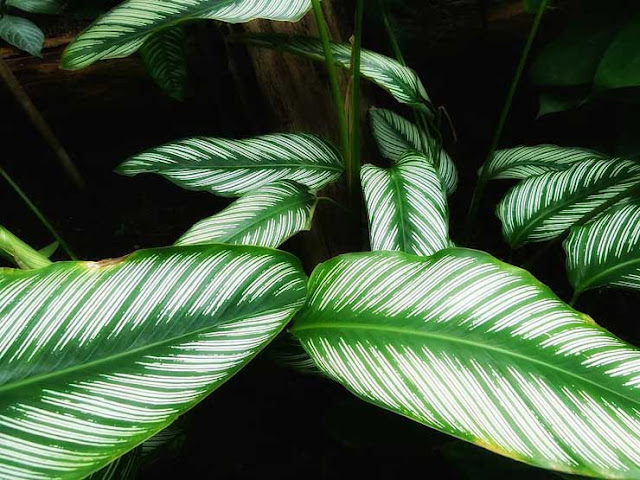
Calathea ornata belongs to the Marantaceae family, which is also known as the Prayer plant family. The pinstripe Calathea ornata is often confused as the prayer plant as it raises its leaves upward in the evening hours as if a person raises his hand during prayer.
Details to know about Calathea ornata.
- Botanical name- Calathea ornata
- Common name- Pin Stripe Calathea, Calathea Pinstripe or Pinstripe plant, peacock plant, zebra plant
- Family- Marantaceae
- Origin- South America (Colombia, Venezuela)
- Plant size- 2 feet wide and 2 feet hight
- Soil requirement- A well-drained fertile soil is ideal for this plant.
- Humidity- The plant wants plenty of humidity for its growth.
- Light requirement- Bright indirect sunlight is best suitable for this plant.
- Water requirement- The plant needs moist soil, but never prefers overwatering.
- Temperature- Plant thrive well under a temperature range of 65 to 85 °F (18 to 29 °C).
- Repotting- Should be done when the plant gets matured and grown-up. It is generally done after the first year of growth.
- Propagation- This plant is propagated by the division method.
- Toxicity- The plant is non-toxic to cats and dogs.
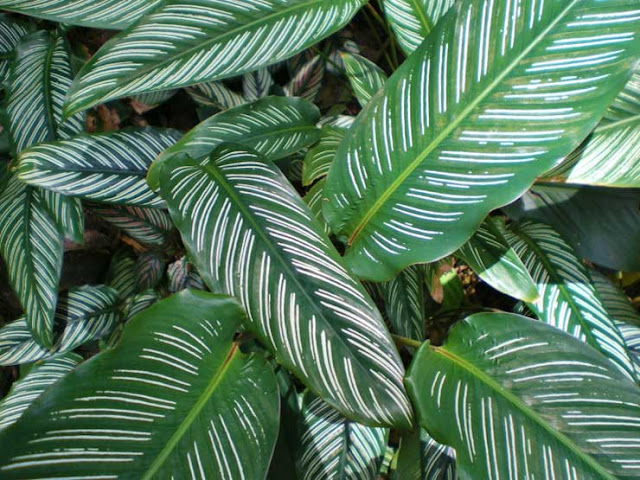
How to care for your Calathea ornata- The pinstripe plant
Here is a complete care guide to Calathea ornata.
Light requirement
Calathea ornata is a tropical plant, and it grows under the shade of the big fat trees in the tropical forest. Therefore, bright indirect sunlight is the ideal light condition for this plant to grow well.
Never expose the plant to bright direct sunlight. It will burn the leaves of the plant and ultimately the plant will die. Too much dim light is also not suitable for the plant.
The ideal place to locate your Pinstripe plant is near an east-facing window that provides adequate light to the plant.
Soil requirement
The plant will love to sit on moist soil, but the soil must not be too wet, soggy, or waterlogged. Well-drained soil with a good fertility level is the true love for the Calathea ornata plant.
A peat-based potting mix will solve all the above requirements. You can mix 2 parts of peat and 1 part of perlite to make an ideal potting mix for the Pinstripe Calathea plant. Perlite improves the drainage property of the soil, avoiding the waterlogging situation. It helps to respire the root properly.
You can also use cocopeat for making the soil moist for a longer period of time.
Temperature
As the Calathea ornata is a tropical plant, it just does not like cooler temperatures. It thrives well under a temperature range of 65 to 85°F (18 to 29°C). The plant is very much susceptible to low temperature, so does not allow the temperature surrounding the plant to go below 60°F or 15°C.
The plant is also susceptible to sudden up and down in temperature. So, try to avoid the cold drifts, if your plant is located near the window.
Humidity
Just like other tropical plants Calathea ornata also loves to stay in a humid place. Higher atmospheric humidity levels make the plant grow well and its bright foliage looks fresher and lusher.
You can locate the plant near your kitchen or bathroom as these places are relatively more humid than the other space in your home. You can also mist the Pinstripe Calathea ornata regularly in order to make the atmosphere more humid and the plants look brighter.
If you want an automated system to control the humidity of the vicinity, then you can invest in a good humidifier. It will adjust the humidity as per your need and make to live freely without any hustle.
A pebble tray is also a good option to make the surrounding more humid.
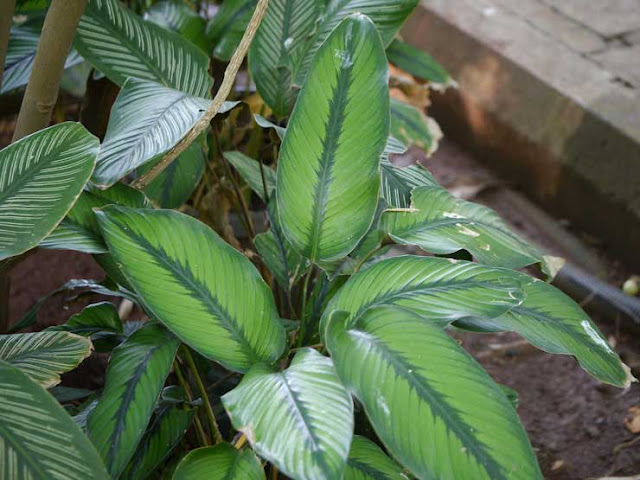
Water requirement for Calathea ornata-
The Pinstripe Calathea ornata loves to be in moist soil, but the soil should not be overwatered or saturated. The waterlogging condition makes the roots suffocate and they can not respire. The prolonged waterlogged condition may also lead to the rotting of roots.
However, the plant is not drought tolerant. If you are not providing it with water for a longer period of time, then the plant will definitely be upset, the leaves will droop and in the long run, the plant will die.
Therefore, you have to regularly check the water requirement of the plant and water accordingly. You can do this by checking the top one to two-inch soil layer. If it is completely dry, then apply water, if it is moist then postpone the plan for today.
Try to supply distilled water at the time of irrigation, as the plant may be negatively impacted by the salts, chemicals, and ions present in the tap water.
Fertilizer requirement of Calathea ornata
This plant never demands too much fertilizer. A general-purpose balanced fertilizer with its recommended dose will do the job perfectly for you. You can also decrease the dose to a little bit if your plant reacts bizarrely.
Organic fertilizer or vermicompost is always recommended, as it is eco-friendly and it also improves the physical condition of the soil.
Never try to overfeed the plant. Higher doses of fertilizer may act as a poison for the plant. The plant will start to behave unnaturally if you have supplied it with a heavy dose of fertilizer. The Pinstripe Calathea ornata plant may also burn.
Regarding the time of application of fertilizers, you can apply once in a month during the summers and winters as this is the period of active growth of the plant. In the winters you don’t need to apply fertilizer, even though you can apply once.
Repotting of Calathea ornata
The pinstripe Calathea ornata plant is to be repotted when the plant grows and it becomes root-bound. After growth of one to two years the plant grows enough in size and its roots also become too much so that the plant becomes root-bound. The growth is also retarded. It is an indication that the plant is needed to be repotted.
- For repotting, you can choose a pot of size 2 inch larger than the previous one.
- Make a suitable potting mix.
- Uproot the plant from the old pot.
- Remove the soil sticking to the roots of the plant.
- Put the plant in the new pot and fill it with the proper potting mix.
Calathea ornata propagation
Plant propagation can be done at the time of repotting. This plant propagated using the division method. During the time of repotting separate a clump of leaves with leaf stalk and roots. Plant it in a new pot. Initially, you can cover the plant with polythene to maintain a higher temperature and humidity, as the plant stabilizes, you can remove the polythene.
Pruning of Calathea ornata
Pruning of Calathea ornata is not really a difficult task to do. You have to prune out the dried and yellow leaves using a sterilized knife. That’s all the plant needs in terms of pruning.
Pest and diseases of Calathea ornata
Calathea ornata plant is relatively less prone to pests and diseases. Sometimes there may seen some sucking pests like thrips, aphids, mealybugs, or spider mites. You can control them using neem spray.
In certain cases, the spider mite infestation may be more serious. These tiny insects suck the sap from various plant parts. The leaves show patches of discoloration. To control this little tiny pest, you can put this plant under a shower. The insect will be wiped out. You can also manually wipe the leaves with a cloth soaked in soap water and then wash with it normal water. You can use neem oil also.
Toxicity
The plant is non-toxic to cats and dogs.
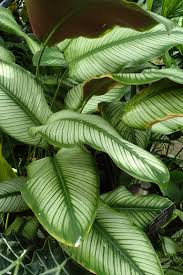
FAQs
Why the leaves of my Calathea ornata are turning yellow?
Yellowing of leaves might be due to overwatering, or any disturbances in the recommended humidity and temperature.
How often should I water my Calathea ornata?
There is no specific time interval or schedule to water your Pinstripe plant. You have to check the top layer of soil regularly and if you found it dry, then go for watering.



